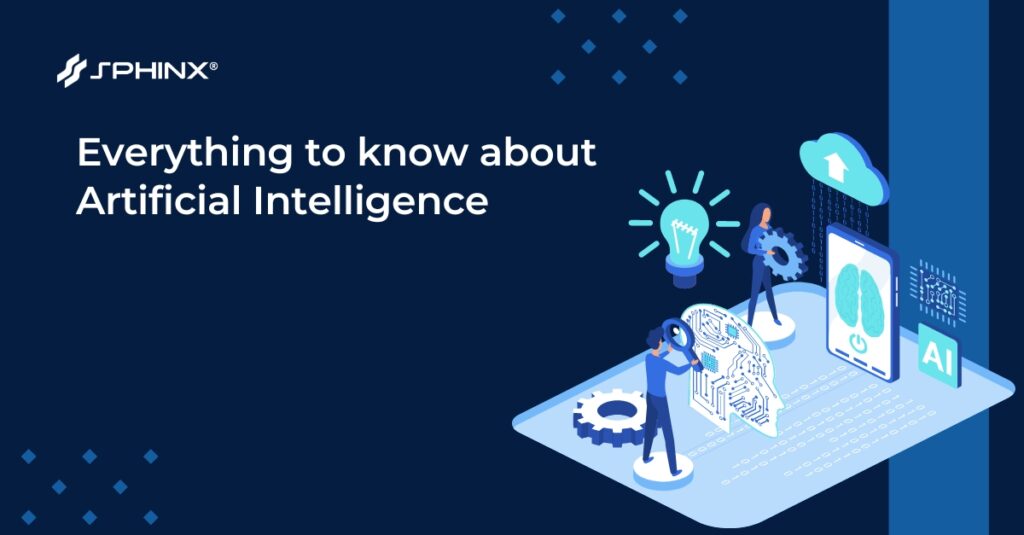Artificial intelligence (AI) has moved beyond the realm of science fiction and firmly established itself in our reality, indicating it’s here for the long haul. As society tries to comprehend the implications of existing AI technologies, its rapid development continues.
AI’s influence can be seen in various sectors, including industrial automation, scientific discovery, and the creative fields. To gain insights into AI, its functionality, its real-world uses, and the importance of standards for its responsible evolution, continue reading.
1. What is the meaning of AI development?
Artificial intelligence (AI) refers to the replication of human intellectual processes by machines designed to mimic human thought and behavior. This includes capabilities such as learning, reasoning, solving problems, understanding perception, and language comprehension.
Artificial Intelligence involves programming computers, robots controlled by computers, or software to mimic human-like intelligence. This is achieved by examining how the human brain functions and understanding its cognitive processes. The insights gained from these analyses are used to create smart systems and software.
2. What are types of AI?
Artificial Intelligence can be categorized into various types depending on its capabilities, functions, and underlying technologies. Below is a summary of the diverse forms of AI:
2.1. Based on Capabilities
2.1.1. Narrow AI (Weak AI)
This kind of AI is built to handle specific functions such as facial recognition, internet searches, or operating vehicles. The majority of modern AI technologies, even those capable of playing intricate games like chess and Go, are categorized here. These systems function within a confined scope or a predetermined set of scenarios.
2.1.2. General AI (Strong AI)
A kind of AI equipped with extensive cognitive abilities similar to humans, allowing it to independently manage new and unknown tasks. This sophisticated AI system has the ability to perceive, learn, and apply its knowledge to overcome any problem autonomously, without human intervention.
2.1.3. Superintelligent AI
This describes a potential version of AI that might exceed human capabilities in every area, such as creative thinking, overall wisdom, and solving problems. The concept of superintelligence is theoretical and has not been achieved yet.
2.2. Based on Functionalities
2.2.1. Reactive Machines
These AI models do not retain memories or prior experiences for subsequent activities. Instead, they evaluate and react to various scenarios. For instance, IBM’s Deep Blue, known for defeating chess grandmaster Garry Kasarov, serves as an illustration of this.
2.2.2. Limited Memory
These AI systems enhance their decision-making capabilities by analyzing historical data. Many of today’s AI applications, including chatbots, virtual assistants, and autonomous vehicles, utilize this approach.
2.2.3. Theory of Mind
This form of AI, which is still under development, involves the capability to comprehend and recall human emotions, beliefs, and needs, and to make decisions based on these factors. It necessitates a deep understanding of human nature by the machine.
2.2.4. Self-aware AI
This signifies a potential future for AI in which machines might develop their own consciousness, becoming sentient and self-aware. Such technology remains hypothetical and would involve AI systems that can comprehend and experience emotions, potentially leading to the formation of their own beliefs and desires.
2.3. Based on Technologies
2.3.1. Machine Learning (ML)
AI systems designed for self-enhancement use experience rather than direct programming for improvement. They focus on developing software that can autonomously learn by accessing and analyzing data.
2.3.2. Deep Learning
A branch of machine learning that utilizes multiple layers of neural networks. This technology is employed to analyze vast datasets and power features such as voice recognition in consumer gadgets, image identification, and numerous other uses.
2.3.3. Natural Language Processing (NLP)
This AI technology allows computers to grasp and analyze human speech. It finds its use in applications like chatbots, translation tools, and sentiment analysis services.
2.3.4. Robotics
This area focuses on the design, construction, operation, and utilization of robots, as well as the computer systems required to control them, provide sensory feedback, and process information.
2.3.5. Computer Vision
This technology enables devices to analyze and understand visual data from the environment, and it is applied in several fields including medical imaging, security monitoring, and industrial production.
2.3.6. Expert Systems
These AI technologies respond to inquiries and address challenges within a particular field of expertise by utilizing systems based on predefined rules.
3. What are the Benefits of AI in development?
Artificial intelligence (AI) has dramatically transformed the business development scene, offering numerous benefits to companies. More and more businesses are adopting AI to enhance their operational efficiencies. Utilizing AI in your business operations can lead to quicker and more precise outcomes.
3.1. Enhanced efficiency
AI technology provides unmatched processing power, enabling companies to quickly analyze large amounts of data. By employing AI algorithms, businesses can enhance various phases of product development, such as ideation, prototyping, testing, and optimization. Automation of repetitive tasks minimizes human error and shortens the time to market, helping companies stay flexible and responsive to market changes.
3.2. Data-driven decision-making
AI equips businesses with the tools to derive meaningful insights from comprehensive data sets. By evaluating historical data on products, customer feedback, market trends, and competitor activities, AI algorithms can identify patterns and forecast future developments. These insights support strategic decision-making, help mitigate risks, and refine product development tactics to more effectively meet consumer demands.
3.3. Improved product quality
AI technologies improve the quality of products through advanced simulations, testing, and validation processes. AI-driven applications can model various scenarios, uncover design issues, and enhance product functionality before physical prototypes are made. This approach saves time and reduces costs associated with multiple iterations, ensuring the end product meets or exceeds expectations.
3.4. Personalized customer experiences
In today’s personalized market, AI is crucial for understanding customer preferences and customizing products to fit those needs. AI analyzes customer data to pinpoint individual tastes, recommend tailored product features, and suggest additional products. These personalized interactions increase customer satisfaction, strengthen brand loyalty, and encourage repeat business.
3.5. Transformative psychometric analysis
AI-driven psychometric analysis explores user preferences and behavioral trends, giving developers critical insights to fine-tune products. This analysis helps understand the nuanced needs of different audiences, enabling the creation of products that resonate more deeply with users, enhancing satisfaction and fostering a stronger user-product connection, which is key to market success.
3.6. Reduced cost
AI helps cut costs in product development by forecasting material needs, reducing waste, and optimizing energy use during production. Automation of routine tasks allows human resources to focus on strategic tasks, thereby boosting overall efficiency.
3.7. Competitive advantage
Integrating AI into product development offers companies a considerable competitive edge. AI-generated insights facilitate rapid responses to market shifts, positioning companies at the forefront of innovation. This agility ensures timely product releases that align with changing consumer needs, staying ahead of competitors. Additionally, AI helps streamline operations, enhancing efficiency and shortening time-to-market, providing a strategic edge.
Final Thoughts
Artificial intelligence (AI) has gained significant popularity in the business industry, driving innovations in automation, data analysis, and customer service. Companies across various sectors are leveraging AI to enhance efficiency, personalize experiences, and gain a competitive edge.
Sphinx stands out as a premier provider of AI services in Vietnam, offering cutting-edge solutions tailored to the evolving needs of businesses. Selecting Sphinx for developing AI ensures access to top-tier expertise, advanced technology, and a commitment to excellence that can transform your operations and elevate your strategic goals.




CEO - Son Le
기타 블로그
블로그
AI Driving Innovation: Key Impacts, Challenges and Market Trends
Artificial Intelligence is rapidly moving from a supportive capability to a central engine of innovation across modern enterprises. Its advancements in automation, generative modeling and real time analytics are redefining how organizations operate, scale and deliver value. As AI becomes embedded into products, workflows and strategic decisions, it is reshaping...
자세히 보기블로그
Top 10 Countries for IT Outsourcing in 2026
IT outsourcing is becoming an increasingly popular strategy as businesses worldwide seek to accelerate digital transformation, reduce operational costs, and access specialized tech talent. With the rapid growth of cloud computing, AI, and software development demands, more companies are turning to global partners to stay competitive and scale efficiently. In...
자세히 보기블로그
Transform Your Business with SAP Consulting Support
In today’s digital-first landscape, enterprise systems must evolve continuously to keep up with rising customer expectations, data complexity, and the demand for operational excellence. SAP plays a central role in this transformation, offering intelligent, integrated solutions that help organizations modernize their operations and drive long-term growth. However, SAP only delivers...
자세히 보기기타 블로그
서비스
IoT 개발
SphinX는 최첨단 IoT 개발 서비스를 제공하여 디바이스를 원활하게 연결하고 혁신적인 솔루션을 제공합니다.
테마서비스
블록체인 개발
우리는 신뢰할 수 있고 안전한 블록체인 기술을 처음부터 설계하는 데 매우 능숙하며, ...
테마서비스
ERP 및 CRM 개발
필요한 ERP & CRM 개발 서비스! 비즈니스 프로세스 간소화 및 조직 효율성 향상....
테마기타 블로그
서비스
IoT 개발
SphinX는 최첨단 IoT 개발 서비스를 제공하여 디바이스를 원활하게 연결하고 혁신적인 솔루션을 제공합니다.
테마서비스
블록체인 개발
우리는 신뢰할 수 있고 안전한 블록체인 기술을 처음부터 설계하는 데 매우 능숙하며, ...
테마서비스
ERP 및 CRM 개발
필요한 ERP & CRM 개발 서비스! 비즈니스 프로세스 간소화 및 조직 효율성 향상....
테마